Structure Analysis of the Fractionator Overhead Vapor Line of a Delayed Coker Unit
Abstract
:1. Introduction
2. Numerical Methods
3. Seismic and Wind Load Analysis
3.1. Analysis Model and Boundary Conditions
3.2. Analysis of Seismic and Wind Effects
3.2.1. Vibration Caused by a Magnitude 2 Wind or a Magnitude 1 Earthquake
- Since the static stress is primarily caused by the gravitational force when the pipelines are connected, the weight increases, and, therefore, the static stress is larger.
- For the pipelines connected or unconnected, the vibration frequencies of modes 1 to 4 are identical under a magnitude 2 wind or a magnitude 1 earthquake, but the vibration frequencies of modes 5 and 6 are different. The primary difference in structures between the connected and the unconnected pipelines is whether the two sections of 24″ pipes are connected and the five sections of 18″ pipes are connected. Because the 30″ main pipe is not changed, it can be inferred that the first four vibration modes are primarily affected by the vibration of the 30″ main pipe, and the fifth and sixth vibration modes are primarily affected by the vibration of the smaller pipes.
- The maximum harmonic response stresses for various vibration modes occur at the 30″ main pipe or the 24″ pipes, which include the support positions of the 30″ main pipe, the intersection positions of the 24″ pipes, and the 30″-to-24″ reducers, as well as the intersection positions of the 24″ pipes and the 20″ pipes. After statistics, two of the positions for the maximum harmonic response stresses are shifted from the 30″ main pipe to the 24″ pipes when the pipelines are connected.
3.2.2. Vibration Caused by Enhanced Winds or Earthquakes
3.2.3. Statistical Study
4. Conclusions
4.1. Main Findings
- The static stress is larger when the pipelines are connected.
- The first four modes of the pipeline vibration are primarily affected by the vibration of the 30″ main pipe while the fifth, and the sixth modes are primarily affected by the vibration of the smaller pipes.
- For the cases of a magnitude 1 earthquake (parallel mode) and a magnitude 2 wind, the maximum harmonic response stresses occur at the same locations.
- The maximum harmonic response stresses for various vibration modes occur at the support positions of 30″ main pipe, the intersection positions of the 24″ pipes, and the 30″-to-24″ reducers, or the intersection positions of the 24″ pipes and the 20″ pipes.
- Two of the positions for the maximum harmonic response stresses are shifted from the 30″ main pipe to the 24″ pipes after the pipelines are connected.
- In terms of the wind effect, the pipelines connected or unconnected can both withstand a moderate typhoon of magnitude 13 without fatigue damage.
- In terms of the seismic effect, the pipelines connected can withstand a strong earthquake of magnitude 5(+) without fatigue damage, while the pipelines unconnected can withstand a very strong earthquake of magnitude 6(−) without fatigue damage, which is better than the pipelines connected.
- Under the action of a magnitude 17 severe typhoon, the stresses for pipelines connected or unconnected are both lower than the yield strength and the UTS. There is no danger of immediate damage in terms of the wind effect.
- The pipelines connected or unconnected can both withstand magnitude 7 earthquakes up to accelerations of 1718 gal (17.18 m/s2) and 2236 gal (22.36 m/s2), respectively, without exceeding the UTS.
- The pipelines unconnected are slightly better than the pipelines connected in terms of earthquake resistance.
- From the previous study [26] and the present study, the primary cause of the pipeline abnormality is the asymmetry of the flow development, which is not closely connected with the pipeline structure.
- The methods for analyzing the wind effect and the seismic effect used in this study can be applied to other equipment to evaluate its operation safety under the action of wind or earthquake.
4.2. Future Work
Author Contributions
Funding
Institutional Review Board Statement
Informed Consent Statement
Data Availability Statement
Conflicts of Interest
References
- Rahman, N.A. Steady State Simulation of a Delayed Coker Unit. Bachelor’s Thesis, Universiti Teknologi Petronas, Bandar Seri Iskandar, Perak Darul Ridzuan, Malaysia, 2009. [Google Scholar]
- Depew, C.A.; Hashemi, M.H.; Davis, J. Evaluation of alternative control strategies for delayed coker by dynamic simulation. In Proceedings of the 1988 American Control Conference, Atlanta, GA, USA, 15–17 June 1988; pp. 240–246. [Google Scholar]
- Kedia, V.; Nallasivam, U.; Ambati, S.R. Disturbance modelling based benefit estimation from advanced process control: Case study on delayed coker unit. In Proceedings of the 2019 Fifth Indian Control Conference, IIT Delhi, India, 9–11 January 2019. [Google Scholar]
- Zhang, K.; Yu, J. Modeling delayed coking plant via RBF neural networks. In Proceedings of the International Joint Conference on Neural Networks, Washington, DC, USA, 10–16 July 1999; Volume 5, pp. 3483–3486. [Google Scholar]
- Chen, W.; Wang, J. Effects of blending ethylene tar on colloidal stability of delayed coker feedstock and pyrolysis process. Pet. Process. Petchem. 2020, 35, 61–64. [Google Scholar]
- Lei, Y.; Chen, X.; Zhang, B.; Chen, Q. Integrated optimization of the fractionation and heat exchange processes in delayed coker with considering steam generation. Acta Pet. Sin. 2015, 31, 572–582. [Google Scholar]
- Ge, X. Technical analysis of reprocessing mixed waste oil into delayed coker. Pet. Process. Petchem. 2022, 58, 13–18. [Google Scholar]
- Deng, Z.; Cai, G.; Li, Y. Influence of high proportion blending catalytic cracking slurry on delayed coker. Pet. Process. Petchem. 2022, 58, 8–12. [Google Scholar]
- Fan, Y.; Lu, Q.; Wu, Z.; Ma, S. Intelligent optimization of three-point steam injection rate in delayed coker furnace based on automatic regulation of heat load. Pet. Process. Petchem. 2022, 51, 86–91. [Google Scholar]
- Paladino, E.E.; Ribeiro, D.; Reis, M.V.; Geraldelli, W.O.; Barros, F.C.C. A CFD model for the washing zone in coker fractionators. In Proceedings of the 2005 AICHE Annual Meeting, Cincinnati, OH, USA, 10–14 April 2005. [Google Scholar]
- Díaz, F.A.; Chaves-Guerrero, A.; Gauthier-Maradei, P.; Fuentes, D.; Guzmán, A.; Picón, H. CFD Simulation of a pilot plant delayed coking reactor using an in-house CFD code. CTF Cienc. Tecnol. Y Futuro 2017, 7, 85–100. [Google Scholar] [CrossRef]
- Ibrahim, S.A.M.; Abdalla, B.K.; Mohamed, A.A.; Elbasher, H.A. Evaluation and simulation of different crude oil in delayed cocker unit (DCU) in Khartoum refinery. Eur. Acad. Res. 2022, 4, 1410–1421. [Google Scholar]
- Albers, J.E. Modeling of a Delayed Coker. Master’s Thesis, Texas Tech University, Lubbock, TX, USA, 1996. [Google Scholar]
- Valenca, P.A.; Waturuocha, A.; Wisecarver, K. 2D axisymmetric temperature profile modelling of a delayed coking drum during pre-run warm up. In Proceedings of the 2015 COMSOL Conference, Boston, MA, USA, 7–9 October 2015. [Google Scholar]
- Mohamed, S.N.; ElSayed, N.A.; Abdallah, S.M.; ElSokary, M. Maximize the gas oil yield from delayed coker unit by optimization between process variables. J. Univ. Shanghai Sci. Technol. 2022, 24, 95–109. [Google Scholar]
- Dai, Q. Vibration-proof measures in the design of pressure piping. Nonferrous Met. Des. 2002, 29, 66–68. [Google Scholar]
- Chen, C.; Hou, Y.; Jiao, Q.; Su, J.; Zhang, S. Stress analysis of suspension bridge long span oil and gas pipeline under wind load. Pipeline Technol. Equip. 2018, 1, 45–50. [Google Scholar]
- Wu, X.; Lu, H.; Huang, K.; Tang, X.; Wu, S.; Shen, G.; Fu, H. Stress analysis of gas pipelines at seismic belts based on the spectrum analysis. Nat. Gas Ind. 2014, 34, 152–157. [Google Scholar]
- Zhou, C. Pipeline stress analysis in petrochemical design. Shandong Chem. Ind. 2017, 20, 129–130. [Google Scholar]
- Ren, S.; Ma, G.; Wang, H. Stress analysis of gas pipeline in tunnel based on ANSYS. Contemp. Chem. Ind. 2015, 44, 2652–2654. [Google Scholar]
- Zhou, B. Analysis of dynamic characteristics of straight pipe under foundation vibration. Mech. Eng. 2020, 6, 26–28. [Google Scholar]
- Zhao, Z.; Li, S.; Xu, D.; Wu, S. Damping program of pipeline vibration and engineering application. Pipeline Technol. Equip. 2011, 3, 54–56. [Google Scholar]
- Yin, H.; Yan, B.; Fang, J. Analysis and calculation of pipeline vibration at outlet valve of oil feed pump. Pipeline Technol. Equip. 2019, 5, 18–20. [Google Scholar]
- Xu, J.; Liao, H.; Dong, F.; Du, G. Numerical analysis of high-drop and long-distance pipeline under earthquake action. Pipeline Technol. Equip. 2018, 6, 5–9. [Google Scholar]
- Capula-Colindres, S.; Terán, G.; Velázquez, J.C.; Caballero-Rosas, A.; Torres-Santillán, E.; Angeles-Herrera, D. Mechanical behavior of X60 pipelines containing pitting corrosion defects based on finite element method. Forces Mech. 2024, 16, 100278. [Google Scholar] [CrossRef]
- Yeh, C.L. Numerical Analysis of the flow in a delayed coker unit fractionator overhead vapor line. J. Chin. Soc. Mech. Eng. 2024, 45, 103–113. [Google Scholar]
- Dassault Systèmes SolidWorks Corporation, 175 Wyman Street, Waltham, MA 02451, USA. Available online: https://www.solidworks.com/support/resource-center (accessed on 15 April 2022).
- ANSYS, Inc. Southpointe, 2600 Ansys Drive, Canonsburg, PA 15317, USA. Available online: https://www.ansys.com/products#t=ProductsTab&sort=relevancy&layout=card&f:@products=[Workbench] (accessed on 15 April 2022).
- Thomson, W.T. Theory of Vibration with Applications, 3rd ed.; CBS Publishers & Distributors: New Delhi, India, 2002. [Google Scholar]
- Fung, Y.C. Foundation of Solid Mechanics; Prentice Hall: Lebanon, IN, USA, 1985. [Google Scholar]
- ANSYS Inc. Theory Reference for the Mechanical APDL and Mechanical Applications, Release 12.0; ANSYS Inc.: Canonsburg, PA, USA, 2009. [Google Scholar]
- Tamkang University, Taiwan. Available online: https://windexpert.ce.tku.edu.tw/newcode/windtable.php (accessed on 31 May 2024).
- Central Weather Administration, Taiwan. Available online: https://www.cwa.gov.tw/Data/service/Newsbb/CH/1081218earthquakepress.pdf (accessed on 31 May 2024).
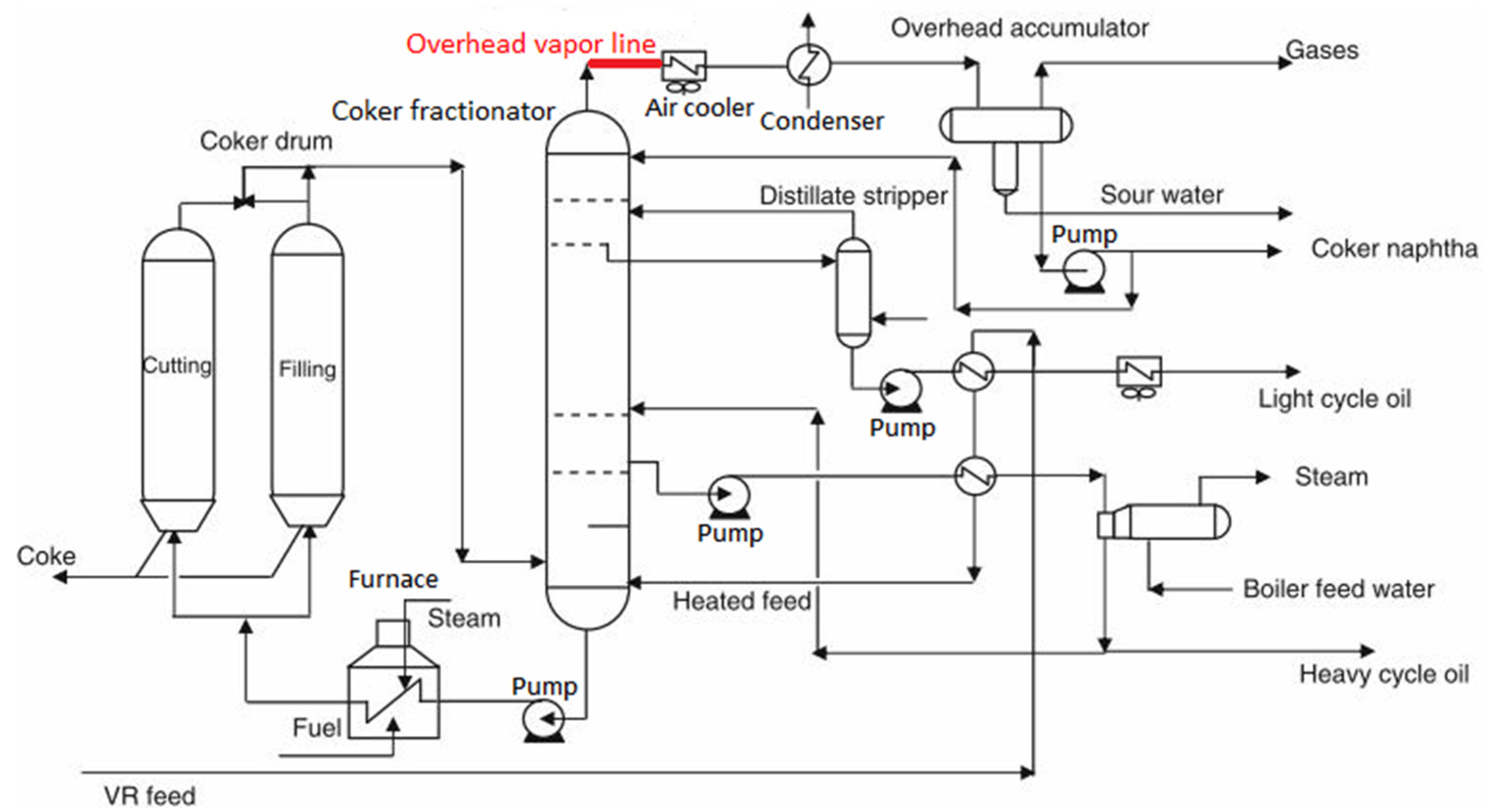

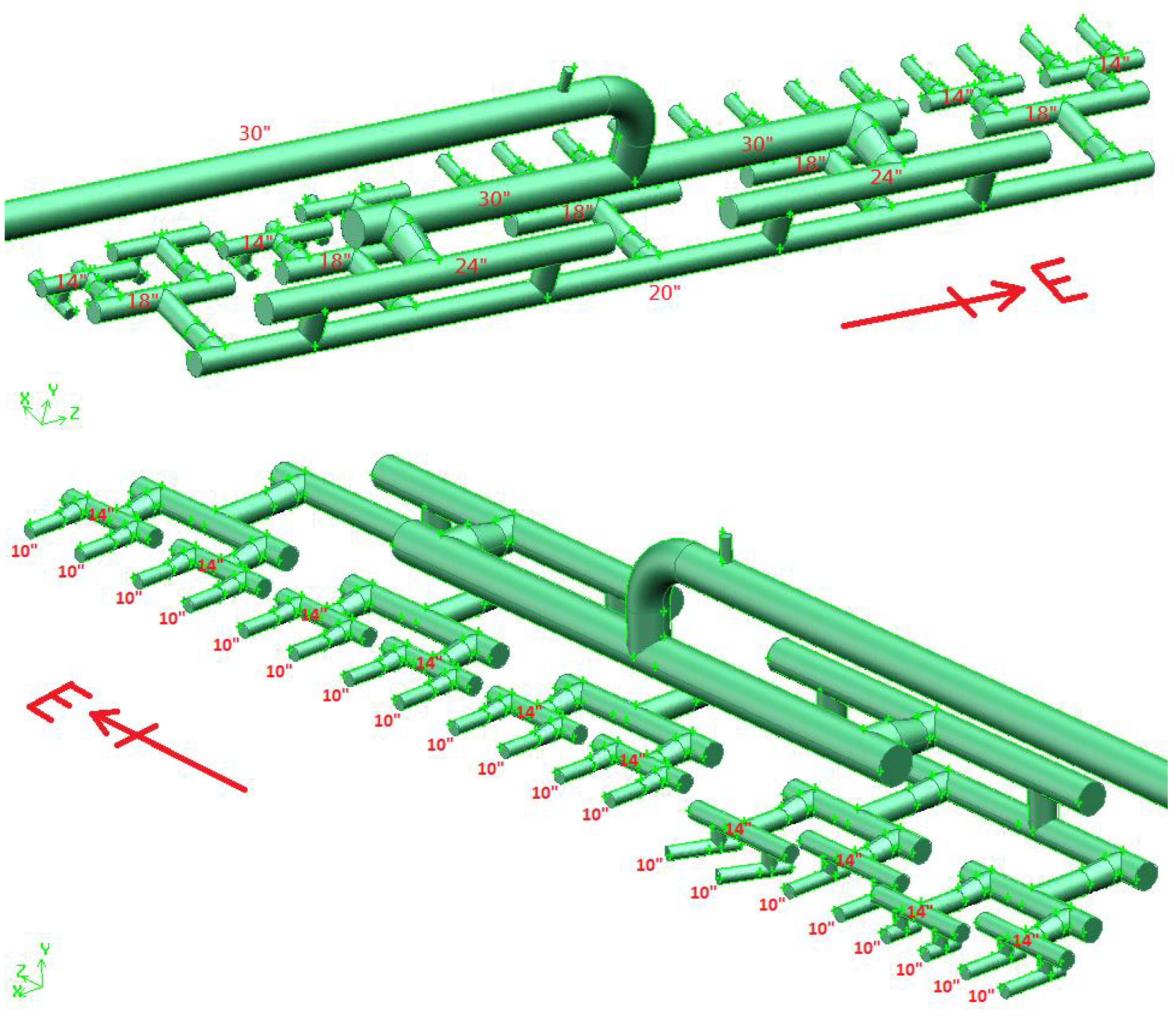
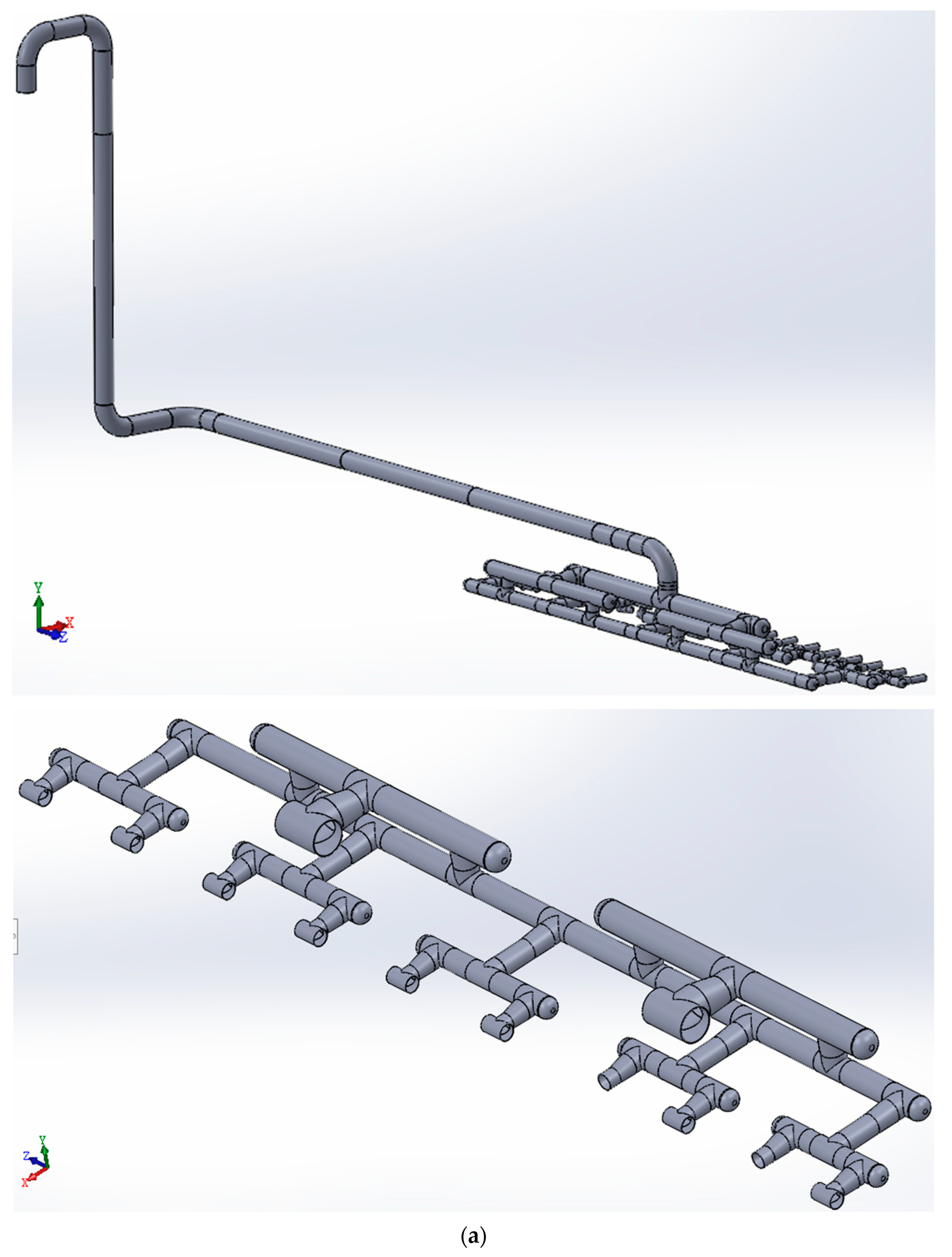
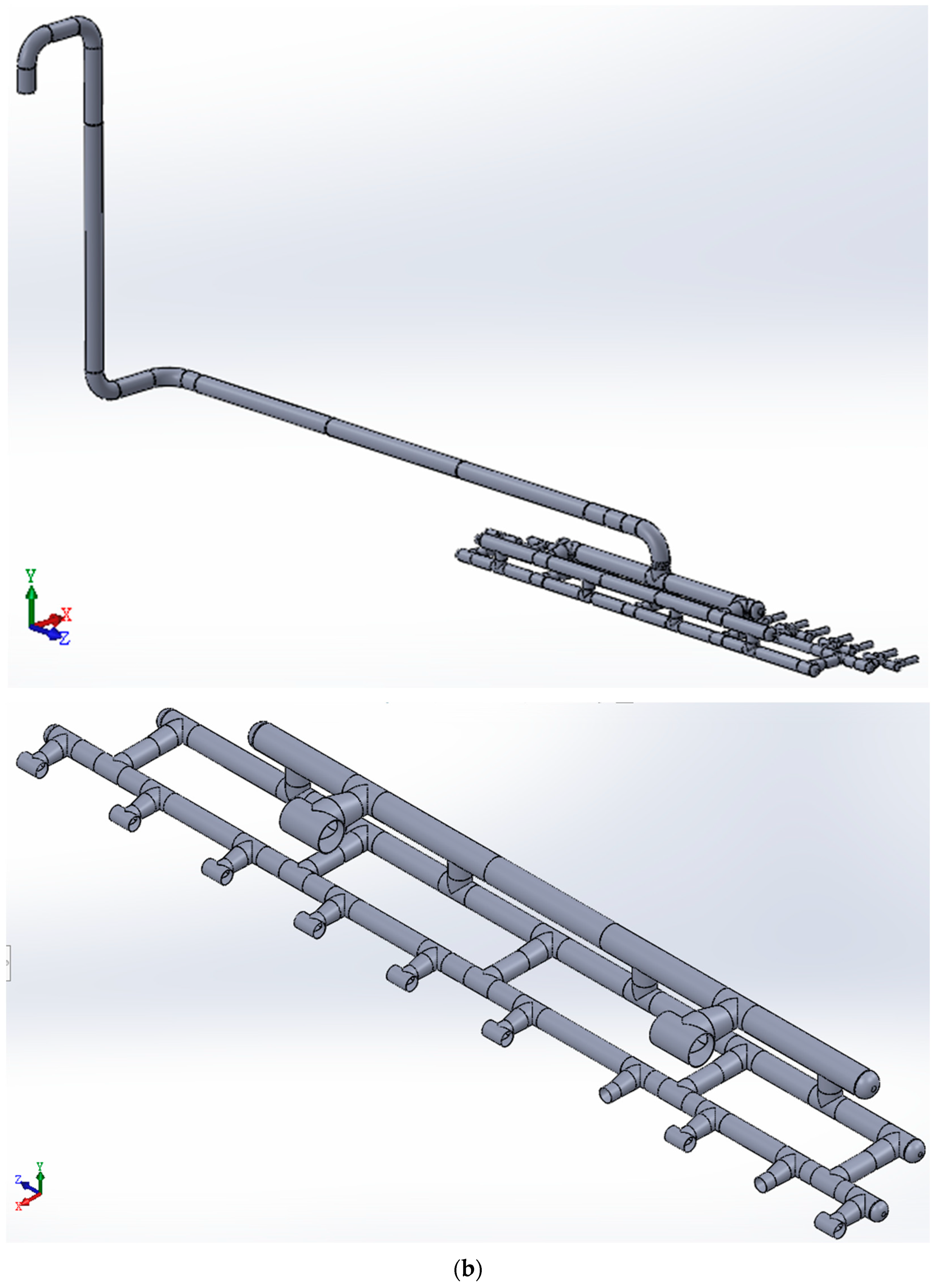


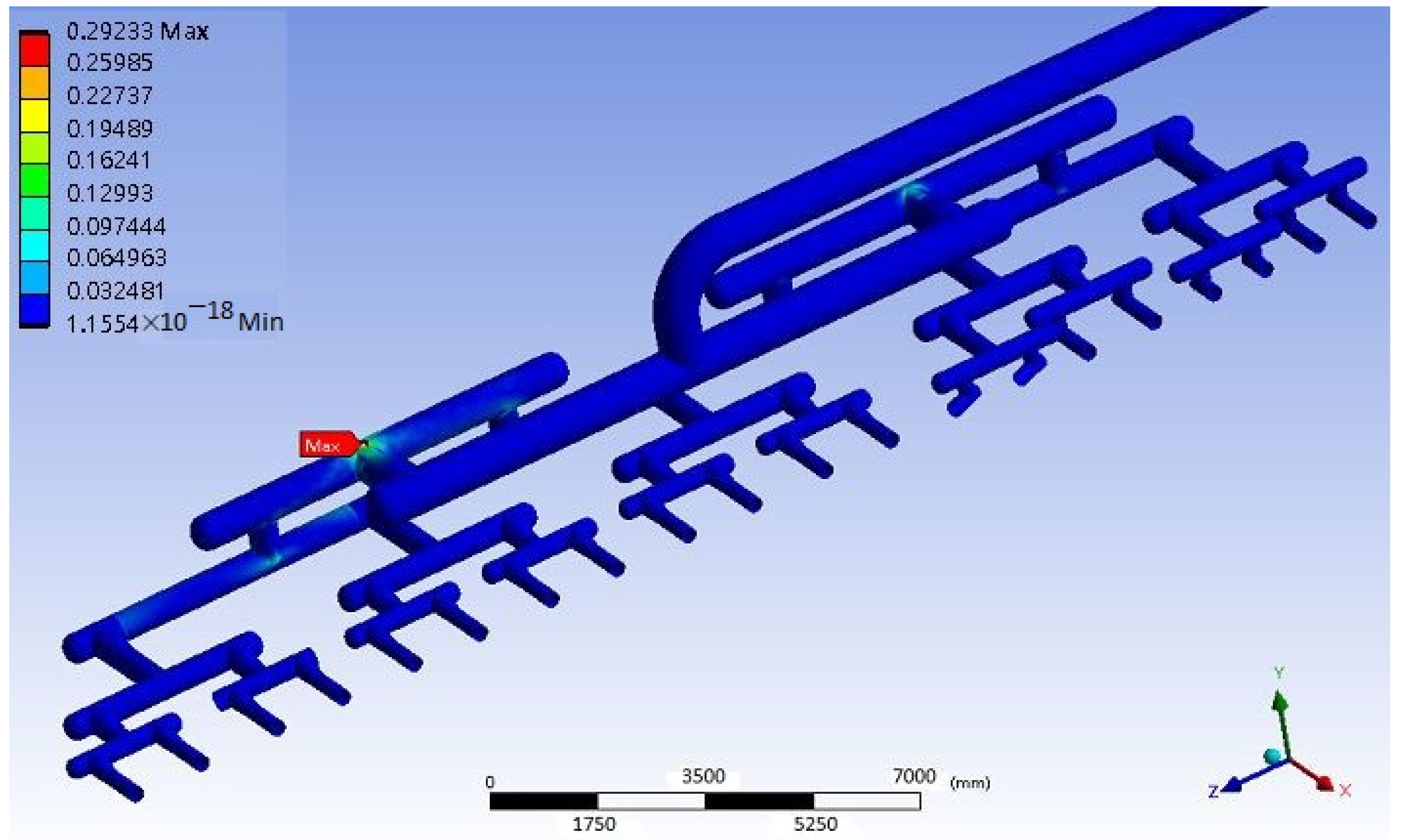
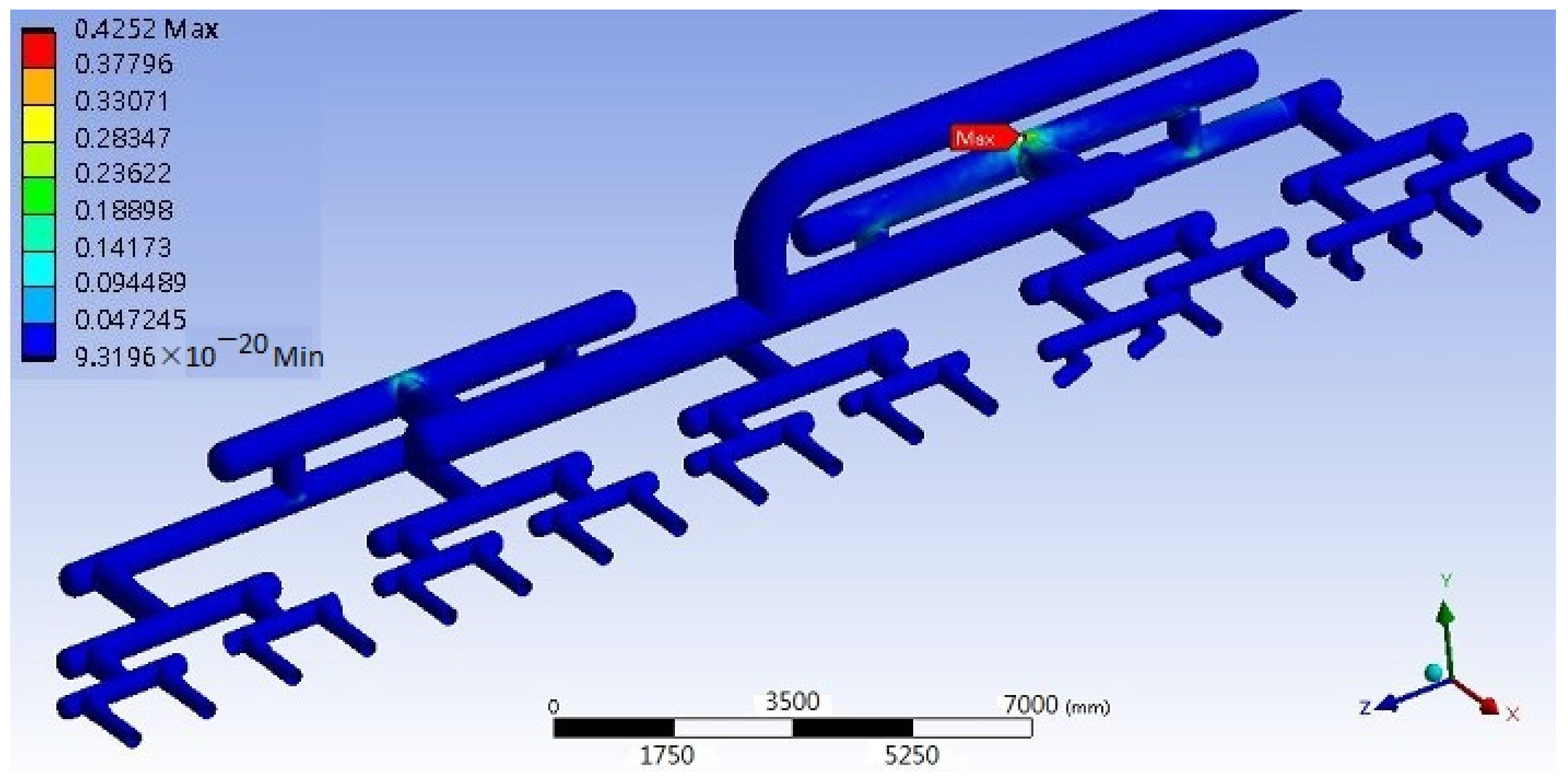
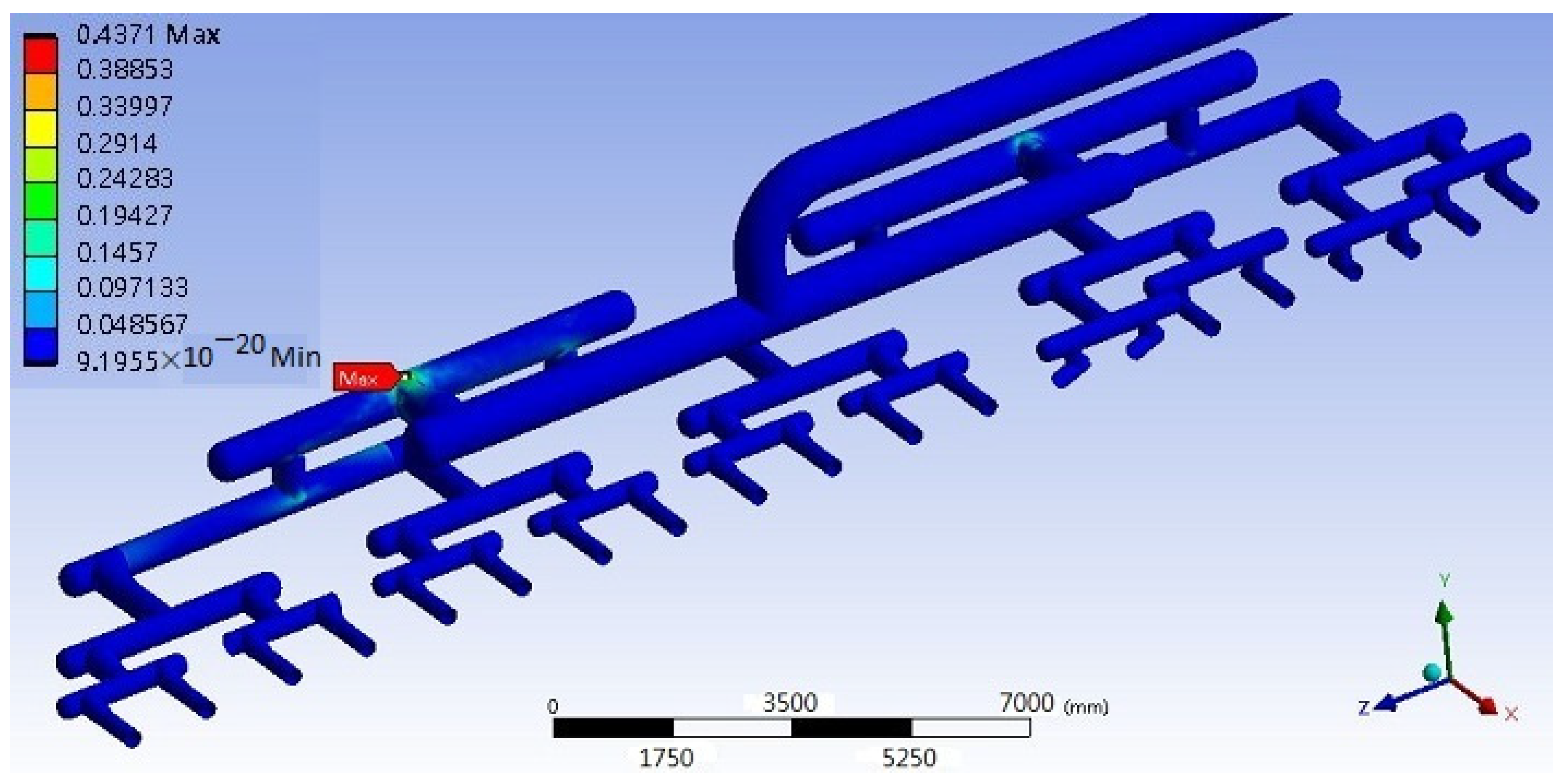
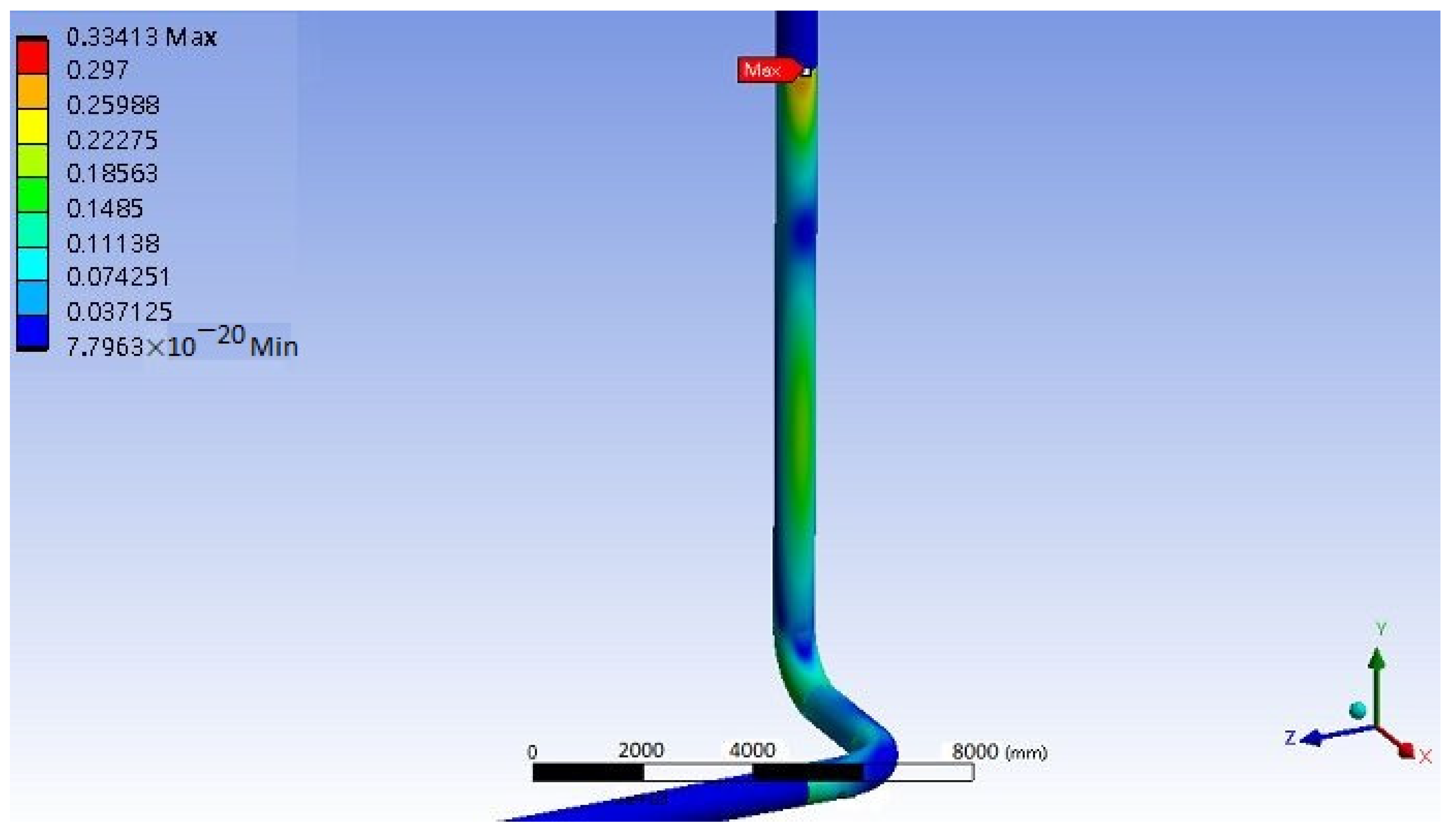
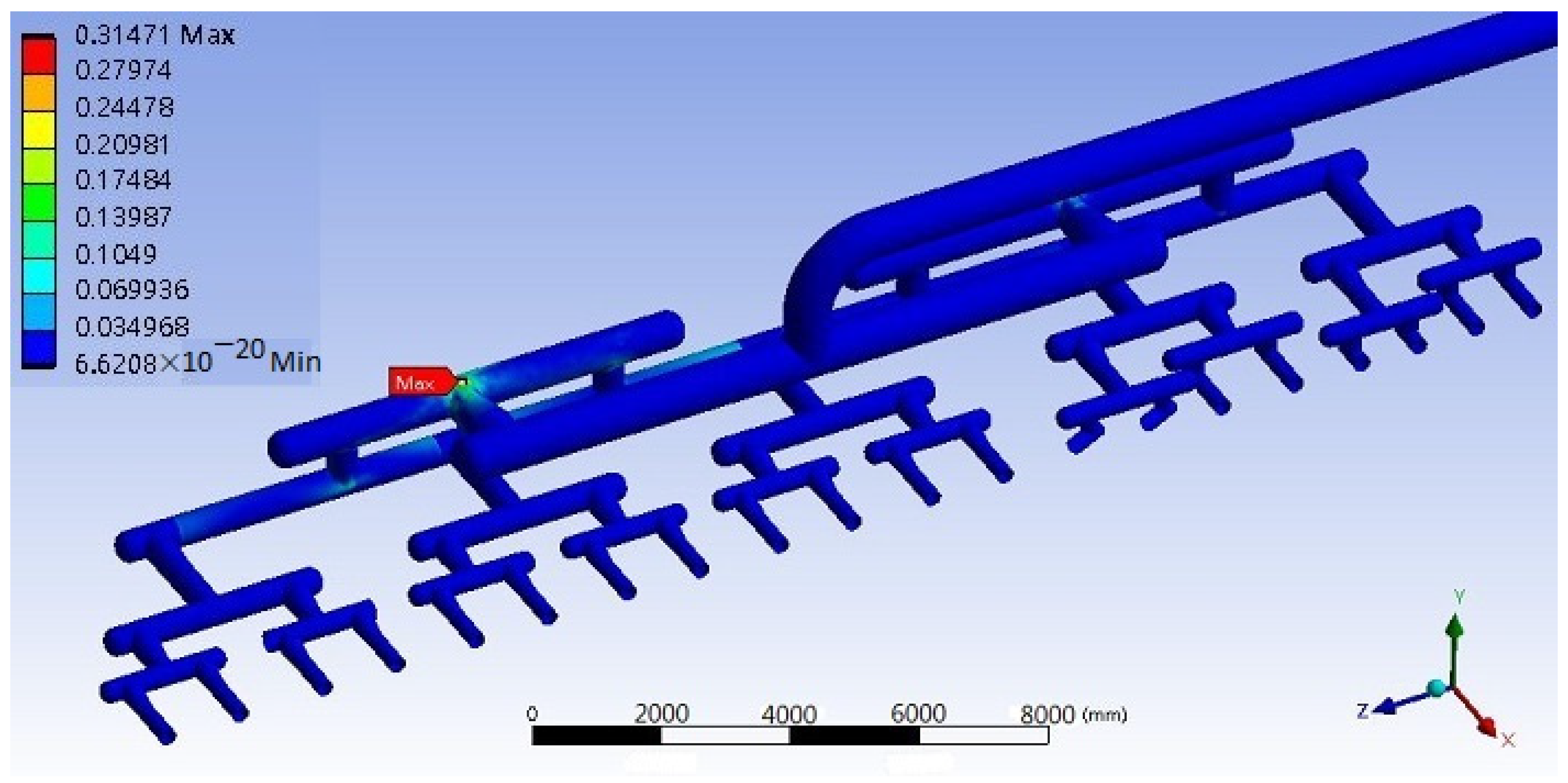
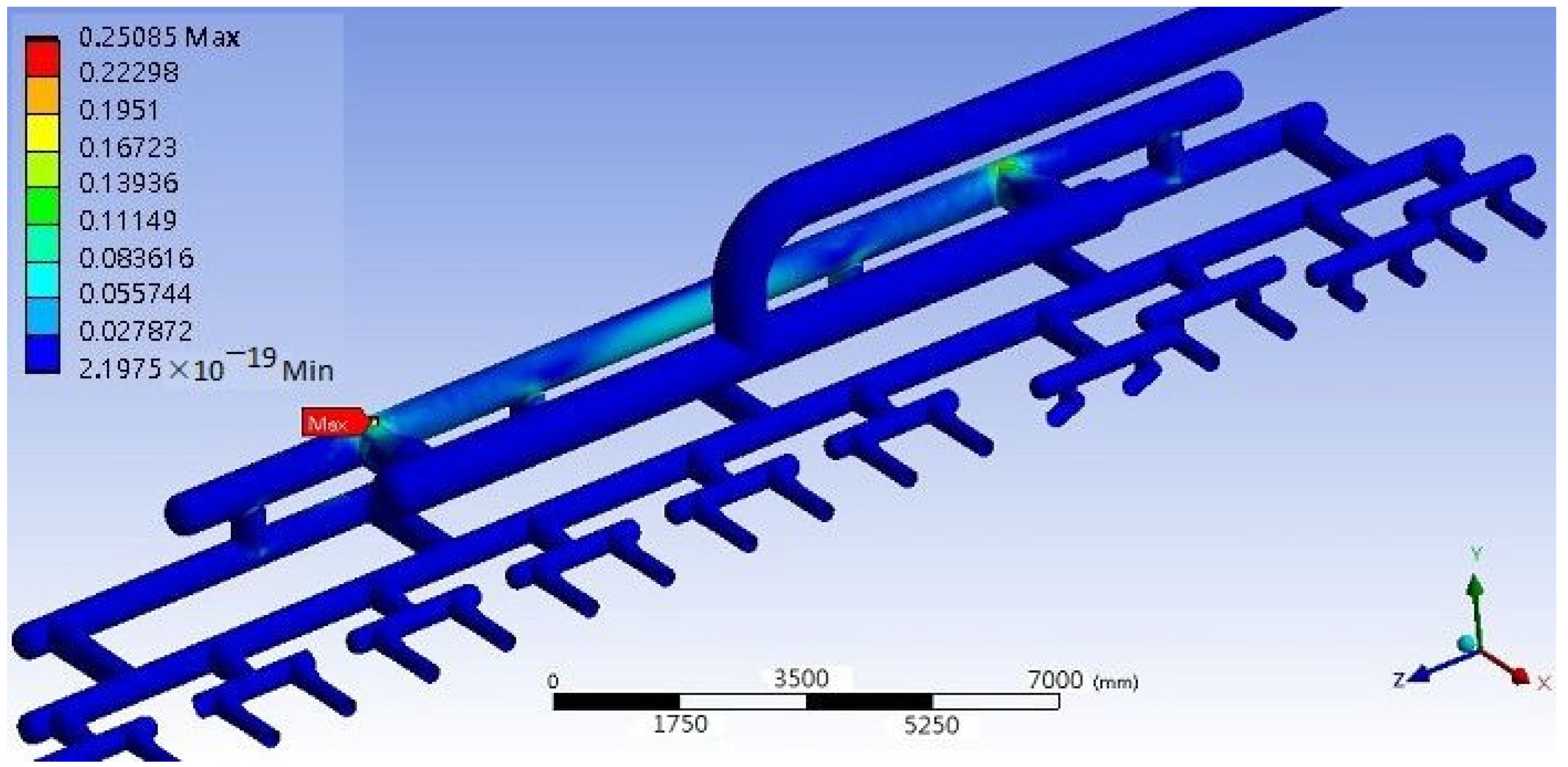
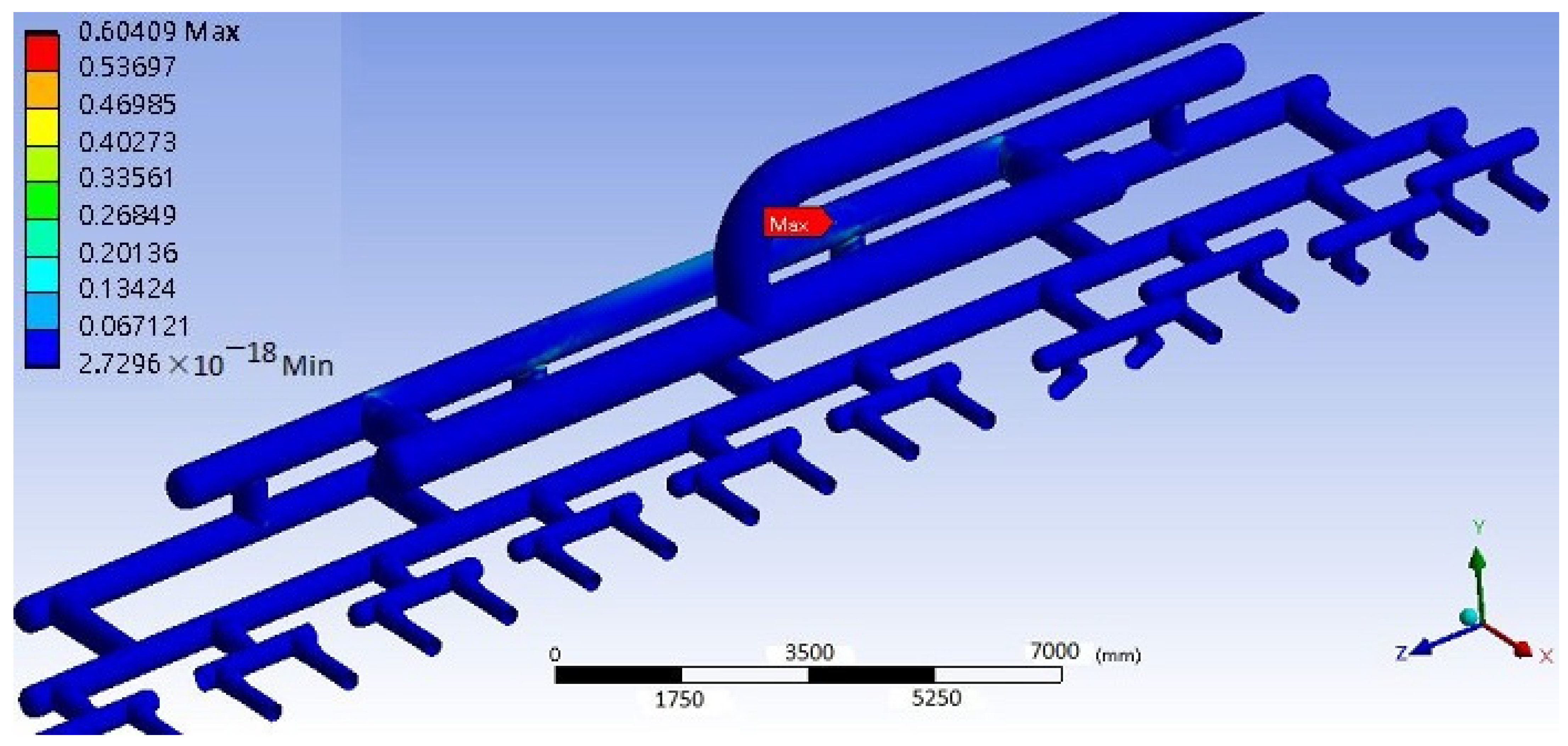
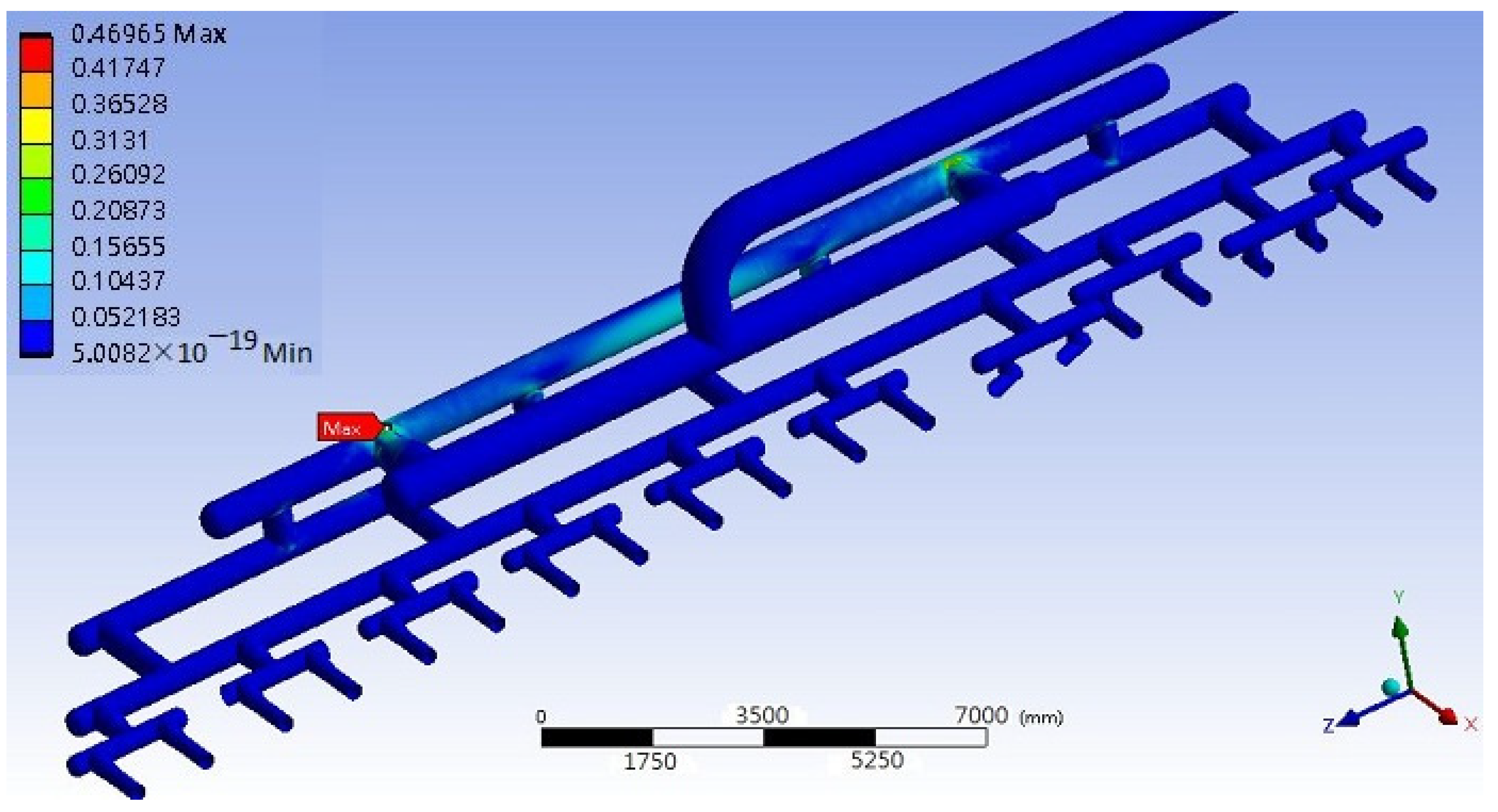

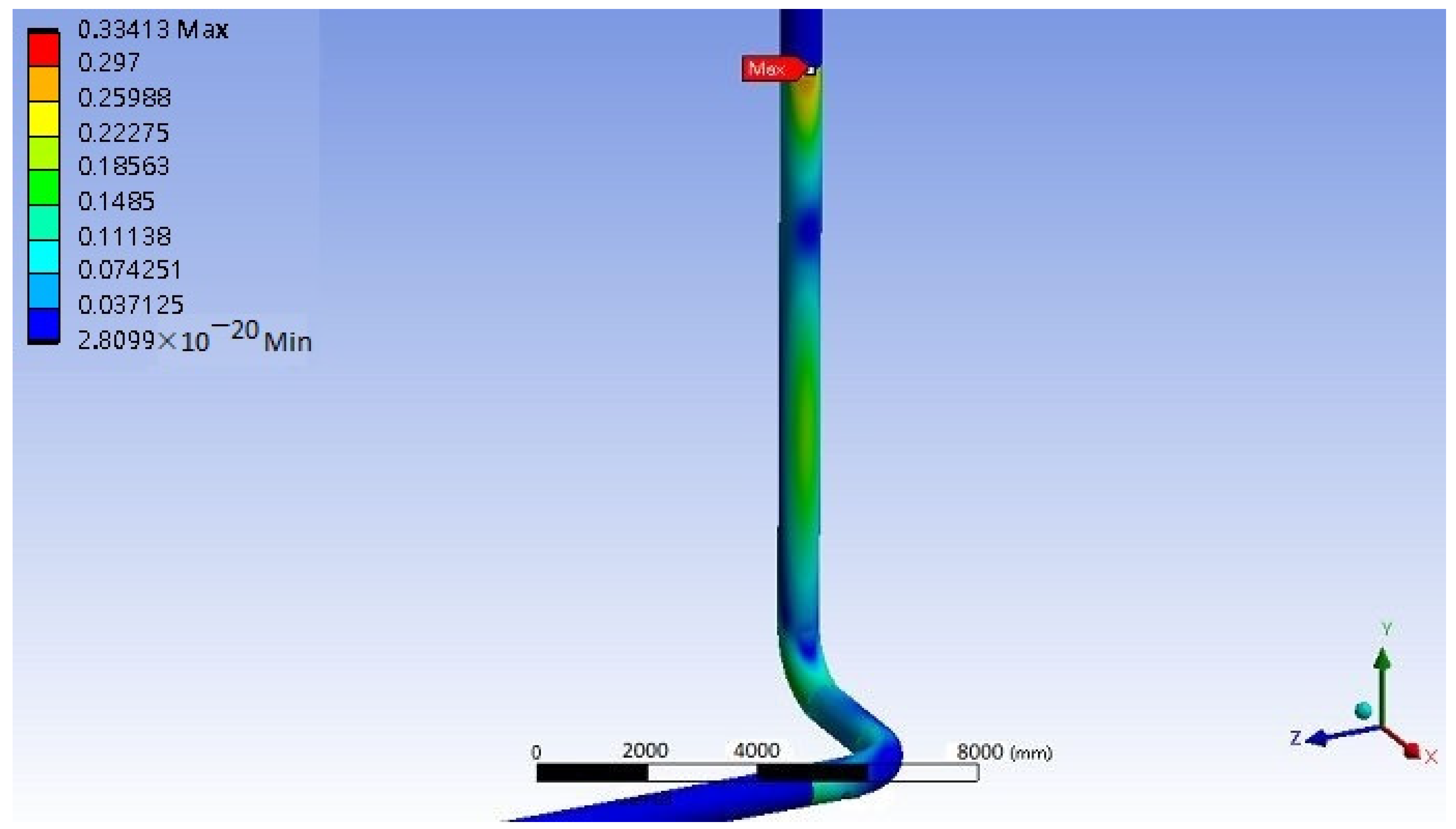
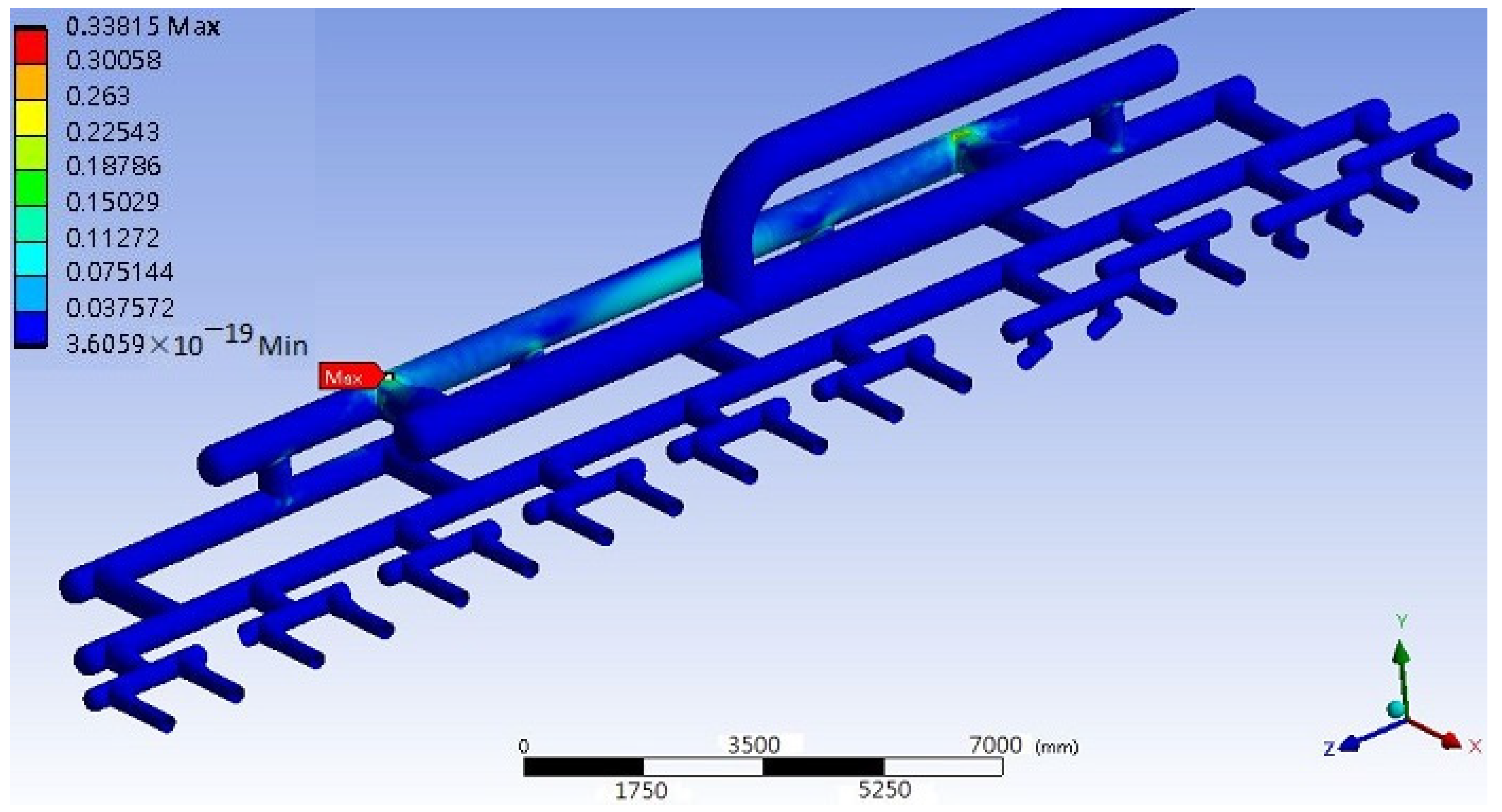
| Size | Do (mm) | t (mm) |
|---|---|---|
| 30″ | 762 | 15.88 |
| 24″ | 610 | 9.53 |
| 20″ | 508 | 9.53 |
| 18″ | 457 | 9.53 |
| 14″ | 355.6 | 9.53 |
| 10″ | 273 | 9.27 |
| Beaufort Scale Number | Description | Wind Speed (m/s) | Wind Load (kgf/m2) |
|---|---|---|---|
| 1 | Light air | 0.0~1.5 | <1 |
| 2 | Light breeze | 1.6~3.3 | 1 |
| 3 | Gentle breeze | 3.4~5.4 | 1~3 |
| 4 | Moderate breeze | 5.5~7.9 | 3~7 |
| 5 | Fresh breeze | 8.0~10.7 | 7~14 |
| 6 | Strong breeze | 10.8~13.8 | 14~23 |
| 7 | Near gale | 13.9~17.1 | 23~35 |
| 8 | Gale (Mild typhoon) | 17.2~20.7 | 35~52 |
| 9 | Severe gale (Mild typhoon) | 20.8~24.4 | 52~72 |
| 10 | Storm (Mild typhoon) | 24.5~28.4 | 72~97 |
| 11 | Violent storm (Mild typhoon) | 28.5~32.6 | 97~128 |
| 12 | Hurricane (Moderate typhoon) | 32.7~36.9 | 128~164 |
| 13 | Moderate typhoon | 37.0~41.4 | 164~206 |
| 14 | Moderate typhoon | 41.5~46.1 | 206~256 |
| 15 | Moderate typhoon | 46.2~50.9 | 256~312 |
| 16 | Severe typhoon | 51.0~56.0 | 312~377 |
| 17 | Severe typhoon | 56.1~61.2 | 377~499 |
| Magnitude | Derivation | Acceleration (m/s2) |
|---|---|---|
| 2 | 1 kgf/m2 × 60.3 m2 × 9.8 N/kgf ÷ 32,189 kg | 0.018 |
| 3 | 3 kgf/m2 × 60.3 m2 × 9.8 N/kgf ÷ 32,189 kg | 0.055 |
| 4 | 7 kgf/m2 × 60.3 m2 × 9.8 N/kgf ÷ 32,189 kg | 0.129 |
| 5 | 14 kgf/m2 × 60.3 m2 × 9.8 N/kgf ÷ 32,189 kg | 0.257 |
| 6 | 23 kgf/m2 × 60.3 m2 × 9.8 N/kgf ÷ 32,189 kg | 0.422 |
| 7 | 35 kgf/m2 × 60.3 m2 × 9.8 N/kgf ÷ 32,189 kg | 0.643 |
| 8 | 52 kgf/m2 × 60.3 m2 × 9.8 N/kgf ÷ 32,189 kg | 0.955 |
| 9 | 72 kgf/m2 × 60.3 m2 × 9.8 N/kgf ÷ 32,189 kg | 1.322 |
| 10 | 97 kgf/m2 × 60.3 m2 × 9.8 N/kgf ÷ 32,189 kg | 1.781 |
| 11 | 128 kgf/m2 × 60.3 m2 × 9.8 N/kgf ÷ 32,189 kg | 2.35 |
| 12 | 164 kgf/m2 × 60.3 m2 × 9.8 N/kgf ÷ 32,189 kg | 3.011 |
| 13 | 206 kgf/m2 × 60.3 m2 × 9.8 N/kgf ÷ 32,189 kg | 3.782 |
| 14 | 256 kgf/m2 × 60.3 m2 × 9.8 N/kgf ÷ 32,189 kg | 4.7 |
| 15 | 312 kgf/m2 × 60.3 m2 × 9.8 N/kgf ÷ 32,189 kg | 5.728 |
| 16 | 377 kgf/m2 × 60.3 m2 × 9.8 N/kgf ÷ 32,189 kg | 6.921 |
| 17 | 499 kgf/m2 × 60.3 m2 × 9.8 N/kgf ÷ 32,189 kg | 9.161 |
| Magnitude | Description | Acceleration | Upper Limit (m/s2) |
|---|---|---|---|
| 0 | Micro earthquake | 0~0.8 gal | 0.008 |
| 1 | Very minor earthquake | 0.8~2.5 gal | 0.025 |
| 2 | Minor earthquake | 2.5~8 gal | 0.08 |
| 3 | Light earthquake | 8~25 gal | 0.25 |
| 4 | Moderate earthquake | 25~80 gal | 0.8 |
| 5(−) | Strong earthquake | 80~140 gal | 1.4 |
| 5(+) | Strong earthquake | 140~250 gal | 2.5 |
| 6(−) | Very strong earthquake | 250~440 gal | 4.4 |
| 6(+) | Very strong earthquake | 440~800 gal | 8 |
| 7 | Great earthquake | >800 gal | >8 |
| Pipelines Connected | Pipelines Unconnected | |||||
|---|---|---|---|---|---|---|
| Case 1 | Case 2 | Case 3 | Case 1 | Case 2 | Case 3 | |
| Static stress (MPa) | ||||||
| 11.854 | 9.0853 | |||||
| Mode | Vibration frequency (Hz) | |||||
| 1 | 9.223 | 9.223 | 9.223 | 9.223 | 9.223 | 9.223 |
| 2 | 23.027 | 23.027 | 23.027 | 23.027 | 23.027 | 23.027 |
| 3 | 29.084 | 29.084 | 29.084 | 29.084 | 29.084 | 29.084 |
| 4 | 29.398 | 29.398 | 29.398 | 29.398 | 29.398 | 29.398 |
| 5 | 37.67 | 37.67 | 37.67 | 43.657 | 43.657 | 43.657 |
| 6 | 45.418 | 45.418 | 45.418 | 45.835 | 45.835 | 45.835 |
| Maximum harmonic response stress (MPa) | ||||||
| 1 | 0.0025649 | 0.29822 | 0.21472 | 0.0025649 | 0.29822 | 0.21472 |
| 2 | 0.043676 | 0.46407 | 0.33413 | 0.02916 | 0.46407 | 0.33413 |
| 3 | 0.057938 | 0.048323 | 0.034793 | 0.035353 | 0.033957 | 0.024449 |
| 4 | 0.059103 | 0.049841 | 0.035885 | 0.035808 | 0.032113 | 0.023122 |
| 5 | 0.25085 | 0.46965 | 0.33815 | 0.29293 | 0.4252 | 0.30615 |
| 6 | 0.60409 | 0.19279 | 0.13881 | 0.29233 | 0.4371 | 0.31471 |
| Maximum Harmonic Response Stress (MPa) for the Pipelines Connected | |||||||
|---|---|---|---|---|---|---|---|
| case | a | Mode-1 | Mode-2 | Mode-3 | Mode-4 | Mode-5 | Mode-6 |
| 1 | 0.025 | 0.002565 | 0.043676 | 0.057938 | 0.059103 | 0.25085 | 0.60409 |
| 2 | 0.025 | 0.29822 | 0.46407 | 0.048323 | 0.049841 | 0.46965 | 0.19279 |
| 3 | 0.08 | 0.008208 | 0.139763 | 0.185402 | 0.18913 | 0.80272 | 1.933088 |
| 4 | 0.08 | 0.954304 | 1.485024 | 0.154634 | 0.159491 | 1.50288 | 0.616928 |
| 5 | 0.25 | 0.025649 | 0.43676 | 0.57938 | 0.59103 | 2.5085 | 6.0409 |
| 6 | 0.25 | 2.9822 | 4.6407 | 0.48323 | 0.49841 | 4.6965 | 1.9279 |
| 7 | 0.8 | 0.082077 | 1.397632 | 1.854016 | 1.891296 | 8.0272 | 19.33088 |
| 8 | 0.8 | 9.54304 | 14.85024 | 1.546336 | 1.594912 | 15.0288 | 6.16928 |
| 9a | 1.4 | 0.14363 | 2.44586 | 3.24453 | 3.30977 | 14.0476 | 33.82904 |
| 9b | 2.5 | 0.25649 | 4.3676 | 5.7938 | 5.9103 | 25.085 | 60.409 |
| 10a | 1.4 | 16.70032 | 25.98792 | 2.70609 | 2.7911 | 26.3004 | 10.79624 |
| 10b | 2.5 | 29.822 | 46.407 | 4.8323 | 4.9841 | 46.965 | 19.279 |
| 11a | 4.4 | 0.45142 | 7.68698 | 10.19709 | 10.40213 | 44.1496 | 106.31984 |
| 11b | 8 | 0.82077 | 13.97632 | 18.54016 | 18.91296 | 80.272 | 193.3088 |
| 12a | 4.4 | 52.48672 | 81.67632 | 8.50485 | 8.77202 | 82.6584 | 33.93104 |
| 12b | 8 | 95.4304 | 148.5024 | 15.46336 | 15.94912 | 150.288 | 61.6928 |
| 13 | 10 | 1.02596 | 17.4704 | 23.1752 | 23.6412 | 100.34 | 241.636 |
| 14 | 10 | 119.288 | 185.628 | 19.3292 | 19.9364 | 187.86 | 77.116 |
| 15 | 0.018 | 0.21472 | 0.33413 | 0.034793 | 0.035885 | 0.33815 | 0.13881 |
| 16 | 0.055 | 0.656089 | 1.020953 | 0.106312 | 0.109649 | 1.033236 | 0.424142 |
| 17 | 0.129 | 1.538827 | 2.394598 | 0.24935 | 0.257176 | 2.423408 | 0.994805 |
| 18 | 0.257 | 3.065724 | 4.770634 | 0.496767 | 0.512358 | 4.828031 | 1.981898 |
| 19 | 0.422 | 5.033991 | 7.833492 | 0.815703 | 0.841304 | 7.927739 | 3.254323 |
| 20 | 0.643 | 7.670276 | 11.93587 | 1.242883 | 1.281892 | 12.07947 | 4.958602 |
| 21 | 0.955 | 11.39209 | 17.72745 | 1.845962 | 1.903899 | 17.94074 | 7.364642 |
| 22 | 1.322 | 15.76999 | 24.53999 | 2.555353 | 2.635554 | 24.83524 | 10.19482 |
| 23 | 1.781 | 21.24535 | 33.06031 | 3.442574 | 3.550621 | 33.45806 | 13.73448 |
| 24 | 2.35 | 28.03289 | 43.62253 | 4.542419 | 4.684986 | 44.14736 | 18.12242 |
| 25 | 3.011 | 35.91788 | 55.89252 | 5.820096 | 6.002763 | 56.56498 | 23.21983 |
| 26 | 3.782 | 45.11506 | 70.20443 | 7.310396 | 7.539837 | 71.04907 | 29.16552 |
| 27 | 4.7 | 56.06578 | 87.24506 | 9.084839 | 9.369972 | 88.29472 | 36.24483 |
| 28 | 5.728 | 68.32868 | 106.3276 | 11.07191 | 11.4194 | 107.6068 | 44.17243 |
| 29 | 6.921 | 82.55984 | 128.473 | 13.37791 | 13.79778 | 130.0187 | 53.37245 |
| 30 | 9.161 | 109.2806 | 170.0536 | 17.7077 | 18.26347 | 172.0996 | 70.64658 |
| Maximum harmonic response stress (MPa) for the pipelines unconnected | |||||||
| case | a | Mode-1 | Mode-2 | Mode-3 | Mode-4 | Mode-5 | Mode-6 |
| 1 | 0.025 | 0.002565 | 0.02916 | 0.035353 | 0.035808 | 0.29293 | 0.29233 |
| 2 | 0.025 | 0.29822 | 0.46407 | 0.033957 | 0.032113 | 0.4252 | 0.4371 |
| 3 | 0.08 | 0.008208 | 0.093312 | 0.11313 | 0.114586 | 0.937376 | 0.935456 |
| 4 | 0.08 | 0.954304 | 1.485024 | 0.108662 | 0.102762 | 1.36064 | 1.39872 |
| 5 | 0.25 | 0.025649 | 0.2916 | 0.35353 | 0.35808 | 2.9293 | 2.9233 |
| 6 | 0.25 | 2.9822 | 4.6407 | 0.33957 | 0.32113 | 4.252 | 4.371 |
| 7 | 0.8 | 0.082077 | 0.93312 | 1.131296 | 1.145856 | 9.37376 | 9.35456 |
| 8 | 0.8 | 9.54304 | 14.85024 | 1.086624 | 1.027616 | 13.6064 | 13.9872 |
| 9a | 1.4 | 0.14363 | 1.63296 | 1.97977 | 2.00525 | 16.40408 | 16.37048 |
| 9b | 2.5 | 0.25649 | 2.916 | 3.5353 | 3.5808 | 29.293 | 29.233 |
| 10a | 1.4 | 16.70032 | 25.98972 | 1.90159 | 1.79833 | 23.8112 | 24.4776 |
| 10b | 2.5 | 29.822 | 46.407 | 3.3957 | 3.2113 | 42.52 | 43.71 |
| 11a | 4.4 | 0.45142 | 5.13216 | 6.22213 | 6.30221 | 51.55568 | 51.45008 |
| 11b | 8 | 0.82077 | 9.3312 | 11.31296 | 11.45856 | 93.7376 | 93.5456 |
| 12a | 4.4 | 52.48672 | 81.67632 | 5.97643 | 5.65189 | 74.8352 | 76.9296 |
| 12b | 8 | 95.4304 | 148.5024 | 10.86624 | 10.27616 | 136.064 | 139.872 |
| 13 | 10 | 1.02596 | 11.664 | 14.1412 | 14.3232 | 117.172 | 116.932 |
| 14 | 10 | 119.288 | 185.628 | 13.5828 | 12.8452 | 170.08 | 174.84 |
| 15 | 0.018 | 0.21472 | 0.33413 | 0.024449 | 0.023122 | 0.30615 | 0.31471 |
| 16 | 0.055 | 0.656089 | 1.020953 | 0.074705 | 0.070651 | 0.935458 | 0.961614 |
| 17 | 0.129 | 1.538827 | 2.394598 | 0.175218 | 0.165708 | 2.194075 | 2.255422 |
| 18 | 0.257 | 3.065724 | 4.770634 | 0.349077 | 0.330131 | 4.371142 | 4.493359 |
| 19 | 0.422 | 5.033991 | 7.833492 | 0.573193 | 0.542082 | 7.177517 | 7.378201 |
| 20 | 0.643 | 7.670276 | 11.93587 | 0.873373 | 0.825969 | 10.93636 | 11.24214 |
| 21 | 0.955 | 11.39209 | 17.72745 | 1.297155 | 1.226751 | 16.24296 | 16.69711 |
| 22 | 1.322 | 15.76999 | 24.53999 | 1.795643 | 1.698182 | 22.48502 | 23.1137 |
| 23 | 1.781 | 21.24535 | 33.06031 | 2.419093 | 2.287793 | 30.29184 | 31.13881 |
| 24 | 2.35 | 28.03289 | 43.62253 | 3.191953 | 3.018706 | 39.96958 | 41.08714 |
| 25 | 3.011 | 35.91788 | 55.89252 | 4.089774 | 3.867797 | 51.21209 | 52.64399 |
| 26 | 3.782 | 45.11506 | 70.20443 | 5.137007 | 4.858189 | 64.32552 | 66.12407 |
| 27 | 4.7 | 56.06578 | 87.24506 | 6.383906 | 6.037411 | 79.93917 | 82.17428 |
| 28 | 5.728 | 68.32868 | 106.3276 | 7.780215 | 7.357934 | 97.42373 | 100.1477 |
| 29 | 6.921 | 82.55984 | 128.473 | 9.400641 | 8.890409 | 117.7147 | 121.006 |
| 30 | 9.161 | 109.2806 | 170.0536 | 12.44318 | 11.76781 | 155.8133 | 160.1699 |
| Resistance to Fatigue | |||
|---|---|---|---|
| - | Pipelines Connected | Pipelines Unconnected | Better Case |
| Wind | up to magnitude 13 | up to magnitude 13 | equal |
| Earthquake | up to magnitude 5(+) | up to magnitude 6(−) | unconnected |
| Resistance to yielding (permanent deformation) | |||
| - | Pipelines connected | Pipelines unconnected | Better case |
| Wind | up to magnitude 17 | up to magnitude 17 | equal |
| Earthquake | up to magnitude 6(+) | up to magnitude 7 | unconnected |
| Resistance to fracture | |||
| - | Pipelines connected | Pipelines unconnected | Better case |
| Wind | up to magnitude 17 | up to magnitude 17 | equal |
| Earthquake | up to magnitude 7 (1718 gal (17.18 m/s2)) | up to magnitude 7 (2236 gal (22.36 m/s2)) | unconnected |
Disclaimer/Publisher’s Note: The statements, opinions and data contained in all publications are solely those of the individual author(s) and contributor(s) and not of MDPI and/or the editor(s). MDPI and/or the editor(s) disclaim responsibility for any injury to people or property resulting from any ideas, methods, instructions or products referred to in the content. |
© 2024 by the authors. Licensee MDPI, Basel, Switzerland. This article is an open access article distributed under the terms and conditions of the Creative Commons Attribution (CC BY) license (https://creativecommons.org/licenses/by/4.0/).
Share and Cite
Yeh, C.-L.; Chung, Y.-H. Structure Analysis of the Fractionator Overhead Vapor Line of a Delayed Coker Unit. Appl. Sci. 2024, 14, 7193. https://doi.org/10.3390/app14167193
Yeh C-L, Chung Y-H. Structure Analysis of the Fractionator Overhead Vapor Line of a Delayed Coker Unit. Applied Sciences. 2024; 14(16):7193. https://doi.org/10.3390/app14167193
Chicago/Turabian StyleYeh, Chun-Lang, and Yu-Hsi Chung. 2024. "Structure Analysis of the Fractionator Overhead Vapor Line of a Delayed Coker Unit" Applied Sciences 14, no. 16: 7193. https://doi.org/10.3390/app14167193
APA StyleYeh, C.-L., & Chung, Y.-H. (2024). Structure Analysis of the Fractionator Overhead Vapor Line of a Delayed Coker Unit. Applied Sciences, 14(16), 7193. https://doi.org/10.3390/app14167193







